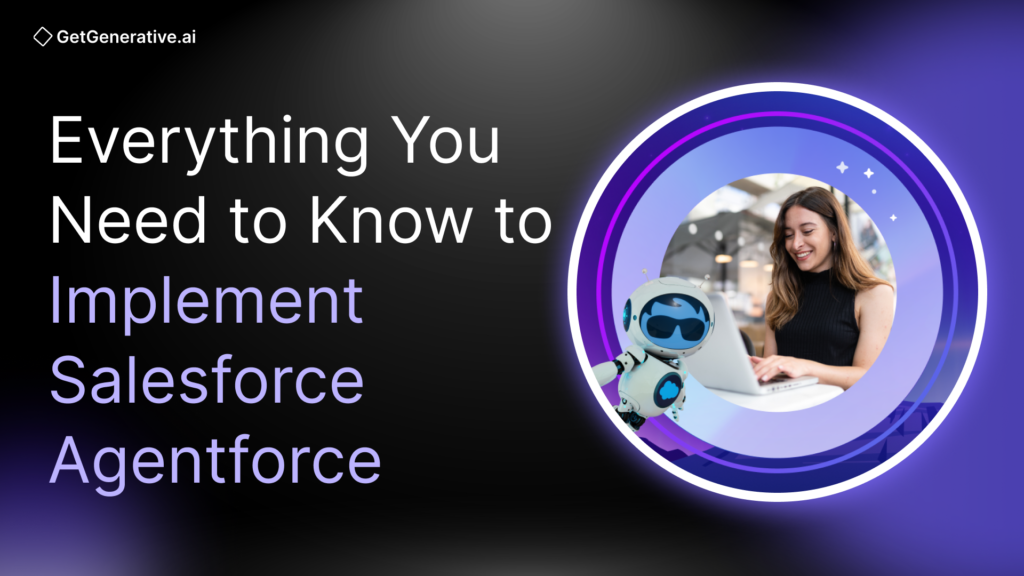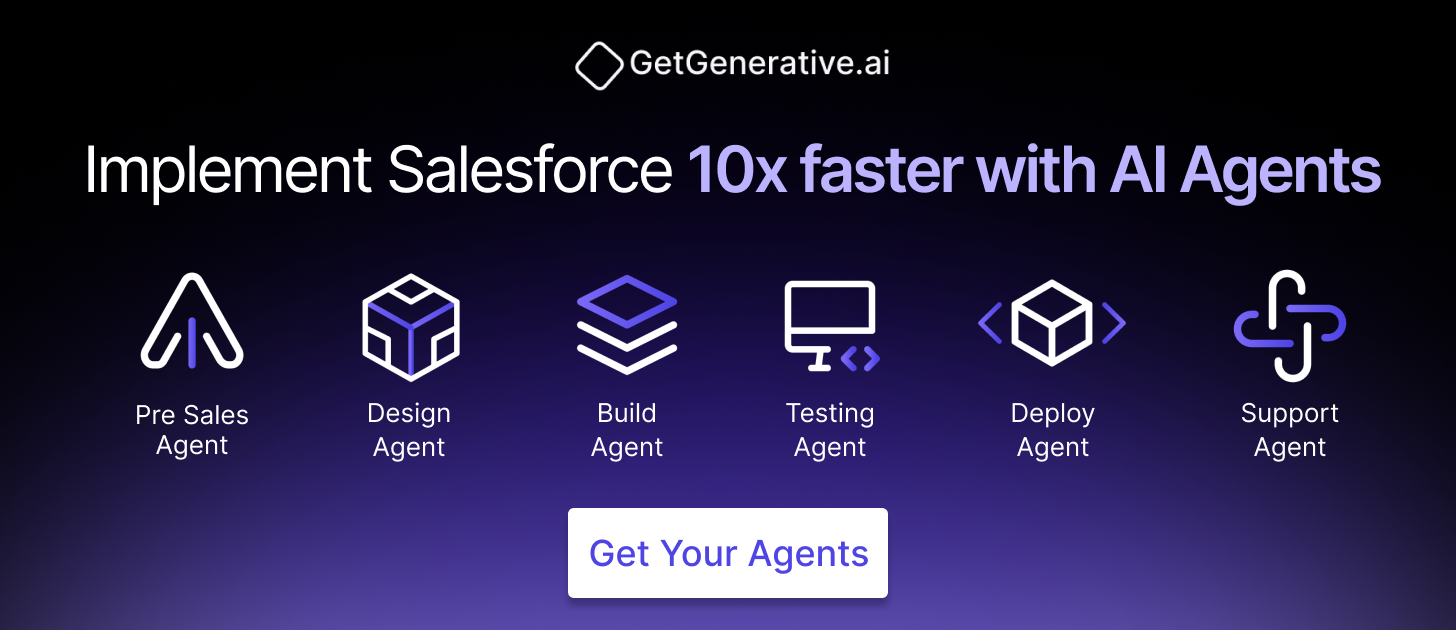Everything You Need to Know to Implement Salesforce Agentforce in 2025
Implementing Salesforce Agentforce in 2025 marks a pivotal step toward enterprise AI maturity.
As Marc Benioff stated, Salesforce aims to “empower one billion agents with Agentforce by the end of 2025,” signaling a transformational shift in how businesses operate.
Agentforce isn’t just another CRM feature—it’s a new architecture for productivity, where AI agents act as digital employees that reason, act, and collaborate across sales, service, and internal functions.
In this in-depth guide, you’ll discover:
- Why 2025 is the optimal time to adopt it
- The key benefits across departments
- Strategic implementation steps
- Real-world examples and best practices
This guide will help you understand and confidently plan your Agentforce rollout. Let’s get started!
Why 2025 Is the Year of Agentforce
Technology Maturity
Agentforce first debuted at Dreamforce 2024. Since then, Salesforce has delivered crucial enhancements now generally available in 2025, including:
- Agent Versioning for safe testing and rollback
- Custom Agent Creation from templates or scratch
- Agent Actions that invoke Flows or Apex
- Voice support (in pilot) with speech-to-text
- Slack and Mobile SDKs for channel flexibility
These features now enable organizations to implement secure, scalable, and highly functional AI agents without writing custom code.
Flexible Pricing Model: Flex Credits
Salesforce introduced a usage-based pricing model in 2025 called Flex Credits:
- ~20 credits per useful action (approx. $0.10)
- Credits sold in packs (e.g. 100,000 credits = $500)
- Pay only for successful outcomes, not just conversations
- Option to convert unused user licenses into credits
- Unlimited internal use licensing model (Summer 2025)
This model ensures organizations can start small and scale Agentforce affordably.
Related Read – Salesforce Unveils New Agentforce Pricing
How to Successfully Implement Salesforce Agentforce
Here’s a step-by-step strategy tailored for 2025:
Step 1: Set Strategic Objectives and Agent KPIs
Start by defining clear, outcome-driven goals that align with your business strategy. For each agent you plan to implement—whether for service, sales, HR, or marketing—identify the specific problem it solves and how success will be measured.
Examples of KPIs:
- First Contact Resolution (FCR)
- Case deflection rates
- Sales lead conversion rates
- Agent onboarding time
- Employee support request handling time
Organizations implementing Agentforce report up to 40% faster case resolutions and a 25% increase in lead conversions.
Establishing quantifiable benchmarks before deployment gives you a way to track value from Day 1 and course-correct as needed.
Step 2: Evaluate Your AI and Data Landscape
Agentforce thrives on context, which means the AI is only as effective as the data and workflows it can access. Conduct a full audit of your Salesforce environment and supporting systems:
- Assess CRM data cleanliness and completeness
- Review existing knowledge articles, FAQ libraries, and documentation
- Identify gaps in user behavior data or disconnected processes
- Map out repetitive, high-friction workflows that could be automated
Survey your teams:
What are the most time-consuming tasks?
Which data do they access frequently?
What feels unnecessarily manual?
Answers to these questions help prioritize which agents to deploy and how to configure them.
Step 3: Tailor Agentforce to Your Business
Agentforce offers flexibility through custom topics, actions, and instructions. Use the Agent Builder to configure agents that align with your unique operations.
For example:
Agent Type | Custom Use Case |
Service Agent | Automate password resets, order lookups, and simple case routing |
SDR Agent | Qualify inbound leads, book meetings via calendar sync |
Sales Coach Agent | Simulate objection handling or suggest pitch improvements |
Merchant Agent | Personalize product recommendations using browsing history |
You’ll also need to:
- Define guardrails and escalation points
- Enable compliance logic for regulated industries (e.g., healthcare, finance)
- Integrate external APIs using MuleSoft if needed
This step ensures each AI agent is not only functional, but deeply embedded in your core business workflows.
Step 4: Deliver Role-Based Training and Simulation Environments
Your agents won’t succeed unless your people know how to use and trust them. Effective adoption starts with realistic, hands-on training:
- Provide in-context guides and interactive tutorials for each user group
- Build sandbox simulations to allow practice without risk
- Use AI scenario walkthroughs (e.g., “Ask the agent to resolve a billing issue”)
- Offer “what-if” exercises to build comfort with automation
Consider enabling your team via Salesforce Trailhead Agentblazer and Salesforce workshops.
Don’t forget to set up an internal knowledge hub where users can share best practices, troubleshoot issues, and access quick tips.
Step 5: Launch a Pilot with a High-Impact Use Case
Avoid a big-bang launch. Start small with a pilot agent focused on a high-value, low-complexity use case—ideally something with measurable volume and fast feedback loops.
Examples:
- Service Agent for handling refund requests and tracking updates
- HR Agent for answering onboarding queries
- SDR Agent for pre-qualifying MQLs
Select a cross-functional test group that includes both tech-savvy and non-technical users to evaluate usability comprehensively.
✅ Salesforce data suggests most Agentforce pilots show measurable ROI in 4–6 weeks.
Set clear evaluation criteria and gather both quantitative performance data and qualitative feedback to refine your agent before scaling.
Step 6: Roll Out in Phases Across Teams
After validating your pilot, roll out in controlled phases—team by team, function by function. Avoid overwhelming users with a sudden shift.
Suggested sequencing:
- Support & Customer Service
- Sales Development & Inside Sales
- Internal Teams (HR, IT, Ops)
- Marketing or Campaign Ops
- Partner Portals or External Stakeholders
At each stage:
- Share early success metrics
- Create internal champions to mentor new users
- Address blockers or feedback before moving to the next team
This incremental approach ensures adoption scales with confidence, not chaos.
Step 7: Monitor Agent Performance in Real-Time
Post-deployment, use Agentforce Analytics and Testing Center tools to monitor how agents are performing in live environments.
Track:
- Interaction volumes and handoff rates
- CSAT scores for agent-handled issues
- Latency, accuracy, and completeness of responses
- Adoption trends by department
Use batch testing with CSV scenarios to simulate new queries or stress test upgrades. Evaluate based on Salesforce’s four performance dimensions: coherence, completeness, conciseness, and speed.
By identifying patterns, you can quickly resolve blind spots and fine-tune agents before issues escalate.
Step 8: Establish a Continuous Innovation Loop
AI agents are not static tools—they evolve with your business. Build a Center of Excellence (CoE) or assign a dedicated team to:
- Review performance reports monthly
- Track user sentiment and emerging needs
- Update Data Libraries and Knowledge Base regularly
- Attend Salesforce Agentforce webinars and release updates
Encourage user feedback loops, such as:
- “Agent says the wrong thing when asked about returns”
- “We need a new topic for product exchanges”
- “Agent could suggest upsells based on browsing history”
Finally, explore advanced options like:
- Multi-agent orchestration
- Voice channels
- Slack bots for internal support
- Integration with LLM APIs or external databases
Agentforce success is not about launch—it’s about iterative evolution.
Also Read – Reinventing Salesforce Implementation with the AI Native Delivery Framework
Core Benefits of Agentforce Implementation
1. 24/7 Digital Productivity
Agentforce acts as a 24/7 digital teammate, completing tasks in real time. Common examples:
- Service: Handle 60%+ of Tier 1 inquiries without escalation
- Sales: Auto-log activities, draft follow-ups, update CRM records
- HR: Deliver onboarding tasks personalized by role
2. Hyper-Personalized, Contextual Service
Agentforce agents leverage Customer 360 and Data Cloud to deliver contextual interactions, including:
- Greeting users by name
- Referencing past interactions
- Customizing next steps based on their stage in the journey
For example, an internal onboarding agent can guide a new employee based on their role, department, and office location.
3. Omni-Channel & Multimodal Support
Agentforce supports users across:
- Web chat
- Slack (via @ mentions or DMs)
- SMS and WhatsApp (via integrations)
- Voice (speech-to-text in pilot)
- Mobile (via SDK, mid-2025 release)
Multimodal Capability: Agents can now process PDFs, screenshots, and structured files. For example:
- A user uploads a PDF insurance policy → Agent parses key terms
- A support agent submits a screenshot of an error → Agent suggests resolution steps
4. Scalable AI Workforce
With new support for multi-agent architecture, companies can create:
- Service Agents
- Sales Coaching Agents
- IT Helpdesk Agents
- Internal Employee Agents
Each with its own rules, datasets, and channels. The low-code setup allows continuous improvements via:
- Agent Versioning
- Safe testing environments
- Modular “Topics” and “Actions”
Start with one agent and scale up, without proportional cost increases.
5. Competitive Differentiation
Early adopters of Agentforce are seeing:
- CSAT improvement via instant resolution
- Higher employee productivity
- Reduced operational costs (fewer escalations, faster task completion)
Example Use Cases:
- Insurance firm resolving claims with AI
- Retailer using AI to restock based on inventory APIs
- SaaS company using internal agents for onboarding and IT support
“Empathy and collaboration are becoming more crucial than coding skills in the AI era.”
– Peter Schwartz, Chief Futures Officer at Salesforce
Real-World Example: Agentforce in a Financial Institution
Let’s explore a realistic scenario of Agentforce deployment in a mid-size bank.
Phase 1 – Customer Service Agent
Use Case: Reduce inbound support tickets for password resets, account inquiries, and lost card issues.
- Built using Agentforce Service Template
- Grounded in Salesforce Data Cloud for customer records
- Knowledge base: FAQs + PDF policies ingested into Data Libraries
- Launched via web chat + mobile app
Outcome: 60% deflection rate for Tier 1 issues within 3 months, improving first-response time by 45%.
Phase 2 – Internal Employee Agent
Use Case: Help bankers and HR staff complete repetitive tasks in Slack.
- Embedded via Slack SDK
- Actions: lookup clients, update contact info, retrieve past interaction history
- Uses MuleSoft API to fetch external data (e.g., credit scores, account history)
Result: 20% time saved per employee task; faster onboarding, higher internal satisfaction.
Phase 3 – Voice Channel & Expansion
The bank later added:
- Voice support: Integrated IVR with Agentforce Voice (pilot)
- IT help agent: Slack-based support for VPN, device issues
- Mixed licensing: Flex Credits for external use, unlimited licenses for internal users
This phased rollout showcases how Agentforce enables both external transformation and internal productivity gains.
Leveraging Advanced Agentforce Features in 2025
Feature | Description |
Agent Templates | Pre-built configurations for Service, Sales, HR, and IT use cases |
Natural Language Agent Builder | Describe the agent you want and let Gen AI draft a starting point |
Agent Versioning | Clone and test safely in sandbox environments |
Slack & Mobile SDKs | Engage users across their preferred channels |
Agent Actions & Filters | Define what agents can and cannot do under certain conditions |
Customer Verification | Built-in OTP-based identity check before sensitive tasks |
Testing Center & Metrics | Batch test agent logic; track coherence, completeness, latency |
Multi-language Support | Expanded to Spanish, German, French, and more in 2025 |
Security, Trust, and Guardrails
Trust and compliance are critical. Salesforce includes:
- Agent Guardrails: Control topic access, restrict sensitive actions
- Einstein Trust Layer: Prevents prompt injections, filters toxic outputs
- Auditing & Logs: Every agent action is recorded and traceable
- Custom Instructions: You can define ethical boundaries (e.g. no medical advice)
Example: A healthcare firm uses built-in Verification Topics before displaying patient data, ensuring HIPAA alignment.
Final Checklist
✅ Clear business goal defined
✅ Use case scoped and prioritized
✅ Data cleaned, mapped, and connected
✅ Internal team trained (Trailhead, Partner, etc.)
✅ Slack, Data Cloud, or MuleSoft integrations configured
✅ Topics, actions, and filters reviewed
✅ Pilot agent tested in sandbox
✅ Monitoring plan in place
✅ Escalation to humans available
✅ Success metrics defined (CSAT, time saved, etc.)
Conclusion
Salesforce Agentforce represents a bold leap into the future of enterprise AI. With proven outcomes, rich features, and accessible pricing, 2025 is the time to deploy digital teammates across your business. Whether your goal is to reduce service volume, support employees, or automate repetitive tasks, Agentforce offers a reliable, secure, and scalable solution.
If you’re considering Agentforce and want a clearer path from idea to execution, GetGenerative.ai can help.
From defining scope and building your first agent to aligning workflows and going live, we bring structure, speed, and clarity to the process.
Book a demo today to see how it works!




